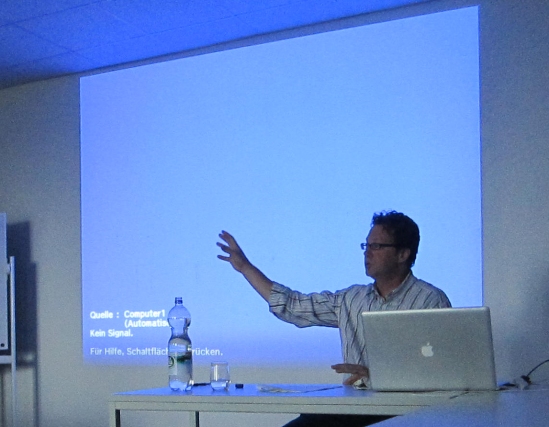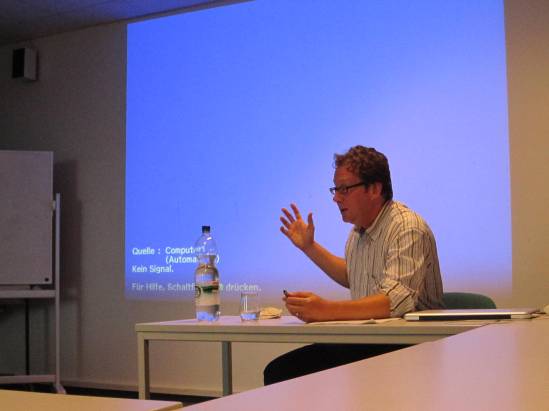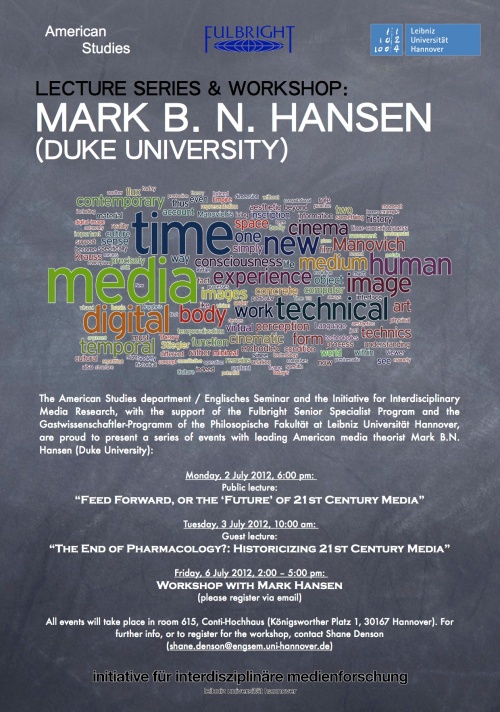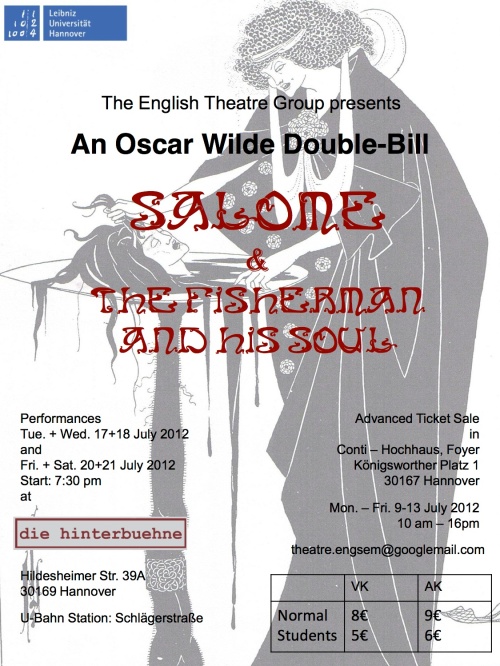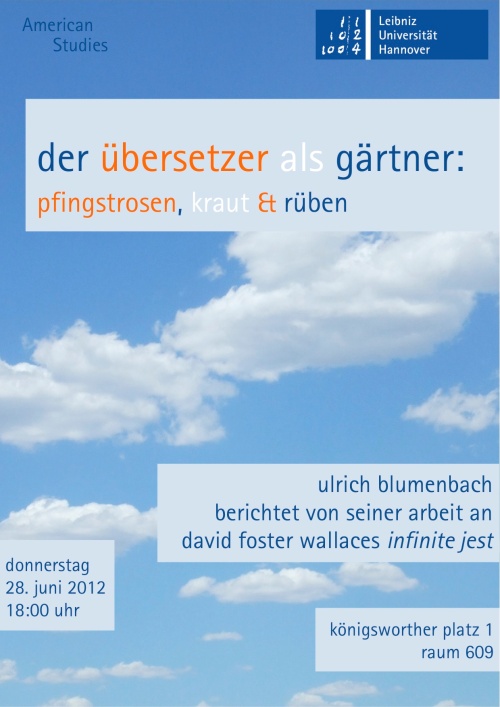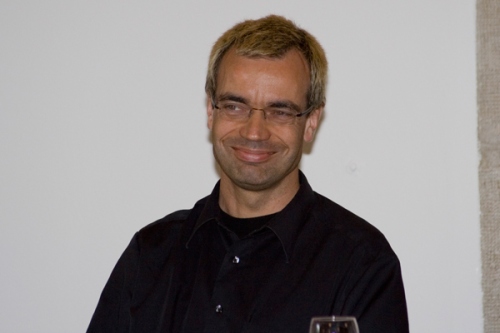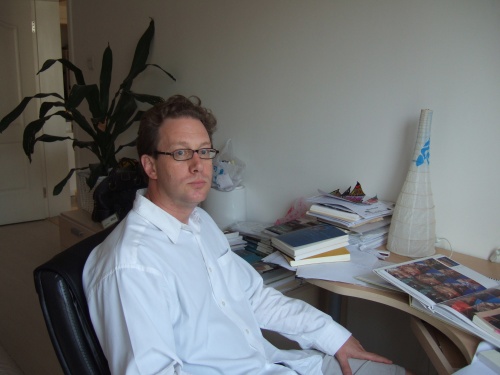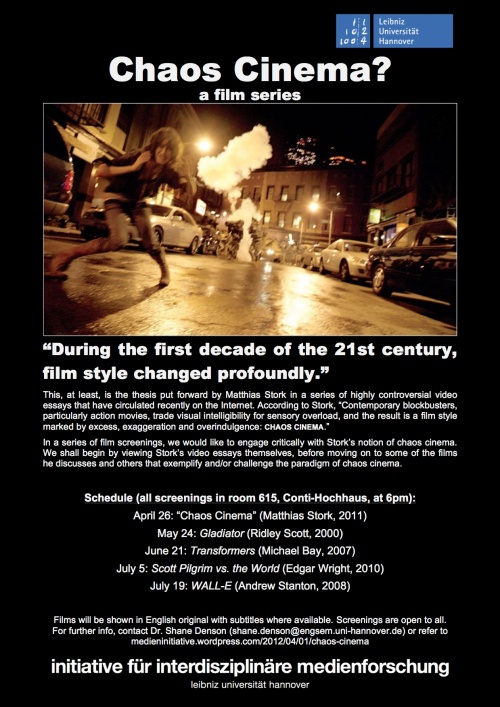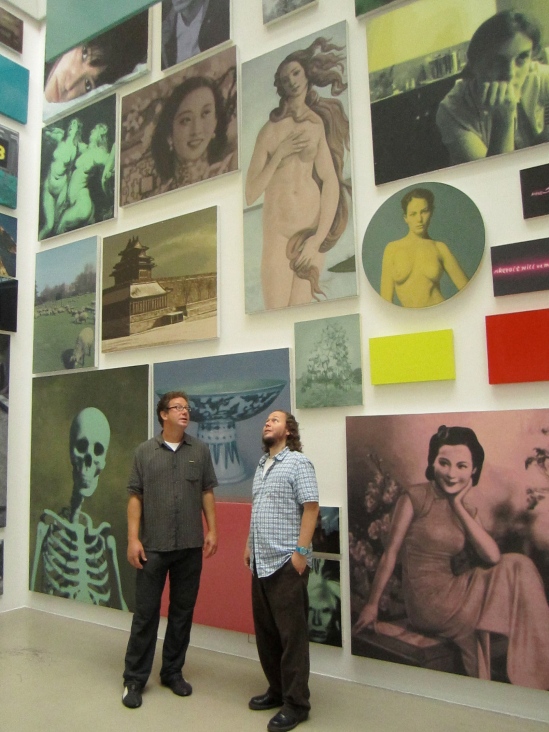
Besides giving lectures and workshops, Mark Hansen has been taking his visit here as an opportunity to see a good deal of art. Last week I accompanied him to the documenta in Kassel, which is really excellent this time around. Lots of opportunities to aesthetically discorrelate and recalibrate — which happens to have been the subject of my “response” (partly synoptic, partly associative, and certainly highly inconclusive) to an article called “Ubiquitous Sensation” that we discussed at the workshop last Friday. Here are the notes I was working with:
Mediate. Discorrelate. Recalibrate. Or: How to Enjoy Impersonal Sensation. Or Yet Again: Having the Time of Your Life and Then Some.
A Response to Mark B. N. Hansen.
Shane Denson, Hannover, 6 July 2012
Mark Hansen’s “Ubiquitous Sensation or the Autonomy of the Peripheral” (forthcoming in Ulrik Ekman’s edited volume, Throughout: Art and Culture Emerging with Ubiquitous Computing) seeks to make sense of the sensory impacts occasioned by computational technologies operating on microtemporal scales – and thus outside the scales proper to subjective perception. Ubiquitous computing, or ubicomp, materially articulates this question, as it is by design “invisible” – which is to say, phenomenally and physically removed from the field of our perceptual attention. And yet, as Hansen shows by way of an exploratory engagement with several artworks, such technologies continue to exert an influence from a position that is radically and resolutely peripheral to perception. Against the claims of early ubicomp visionaries, who imagined this peripherality and invisibility as always ultimately serving the centered (perceptual) subjectivity of deliberate human action, Hansen maintains that because the microtemporal operations enacted by these technologies are categorically beyond or below the threshold of our perception, ubicomp must be seen as instantiating a level of material autonomy, the “autonomy of the peripheral,” that requires us to rethink media and their relation to human experience.
At stake, then, on one level, is a new conception of media, one that breaks with a long-standing tendency to correlate media with human sensory ratios, and to see media as vehicles for storing and reproducing human perceptual experience. Centrally, this tendency is related to Western thought’s privileging of the visual register, which itself can be seen as an exemplary means of constituting media as objects, locating them squarely in the purview of our subjective gazes, and thereby neutralizing any fundamental transformative potential that they might have if accorded autonomy from our perceptual control. It might be helpful here to recall Bruno Latour’s distinction between “intermediaries” and “mediators.” Intermediaries serve as channels that more or less transparently relay information or experiential content from point A to point B. Assuming that those points are people, or subjects, media as intermediaries offer perceptual objects that, because their contents are isomorphic with the contents of natural perception, can circulate in such a way as to expand the power (and life-span or historical longevity) of visual or other perceptual experience without thereby challenging or undermining the foundational stability and centrality of the subject. Mediators, on the other hand, are radically transformative; unlike intermediaries, they are not objects that pass neutrally between subjects but are instead what Latour calls hybrid “quasi-objects,” which articulate the very distinctions and relations obtaining between subjects and objects. By asserting the autonomy of the peripheral, by disconnecting ubicomp and related technologies from the narrow bandwidth of subjectively defined instrumentality, and more generally by discorrelating media from human perception, Hansen similarly breaks with the view of media as intermediaries, and – by positioning media as environmental factors – he shows them to be like Latour’s mediators in their ability to impact us materially, impersonally, and prior to the articulation of subjectivity.
This only works, though, if the discorrelation of media from perception does not imply their complete removal from the domain of sensation. In other words, sensation itself must be seen as occurring outside of perceptual subjectivity, and this impersonal sensation will be the site of our primary, pre-personal interaction with technics. Through discorrelation, in other words, the impact of media is not at all diminished; on the contrary, its directness in fact becomes apparent for the first time. Moreover, perceptually discorrelated media do not remain disconnected but operate precisely by effecting various means and forms of recalibration. Thus, the central experiential impact of invisible computing is constituted by its capacity to recalibrate our microsensory (and thus sub-personal, unconscious) capacities with an environment transformed by the introduction of technologies operating on microtemporal scales – and indeed embodying, operationally, microsensations of their own. In comparison to Hansen’s insistence, in earlier writings, on the relative privilege of the human, here we see a flattening of the difference between humans and computational technics: not, certainly, the crude sort of flattening that posits our brains are “like” computers or, even more extremely, that proposes uploading consciousness into computer networks and leaving our bodies behind. Instead, the analogy between the microtemporal processing of the brain and the microtemporal processing of digital technologies is based, somewhat paradoxically, on a radical naturalization of sensation, one which corresponds to a recognition of our material existence and evolution as embodied organisms in the world, prior to our development of subjectivity. Quite simply put, this priority of the physical – which is both a logical and a temporal priority – requires a radical revision of subject-centered phenomenological accounts of time-constitution. If we are to take seriously the idea of a natural continuum that links the human with nonhuman animals and inanimate materiality as a fact of our embodiment, we must assume that time is in the world before it is in us. Temporal experience therefore arises from a domain of impersonal sensation, and it is here that brains and processors interface directly, materially, and microtemporally, to generate new forms of macroconscious experience, reflecting a new correlation of media and sensation.
It is only on the basis of seeing ourselves as part of the broader – independently temporal and impersonally sensory – world that we are able to appreciate the radical impact of technics outside our subjective experience. More difficult, though, than the theoretical grounding of such an appreciation is the question of how such impersonal sensation can be opened to experience in practice; or, as Hansen puts it more precisely, “how embodied human mind-bodies can enjoy such impersonal sensation” (81). I highlight this formulation because I want to pursue briefly the double meaning of our enjoyment of the impersonal and the microtemporal – not just how we partake of it and participate in it, but how we enjoy it in the sense of our contemporary entertainment industries, which are all highly dependent on the microtemporal processes of digital technologies. Contemporary cinema utilizes CGI both invisibly and spectacularly, and at times it seems to produce “discorrelated images” – images that insist on their excess with respect to viewers’ capacities to capture and process them perceptually. Perhaps more radically, the processual temporality of video games completely resists assimilation to Stiegler’s model of the industrial temporal object, as the medium’s defining interactivity works to ensure a future-oriented openness that is the very antithesis of media as tertiary memory. Moreover, as Andreas Jahn-Sudmann and I have begun to explore, practical and formal experimentation with temporal processes in video games – ranging from user-initiated speedruns to computationally anchored phenomena like the ability to switch to a “bullet time” perspective – might offer a form of aesthetic mediation of impersonal, microtemporal sensation not unlike the artworks that Hansen mentions in his paper. As a popular negotiation of digital microtemporality, it would seem that this is how we “enjoy” impersonal sensation today.
And finally, here are some more (discorrelated/discorrelating) pictures from the documenta, featuring bees as sculpture and painted dogs. Enjoy!




